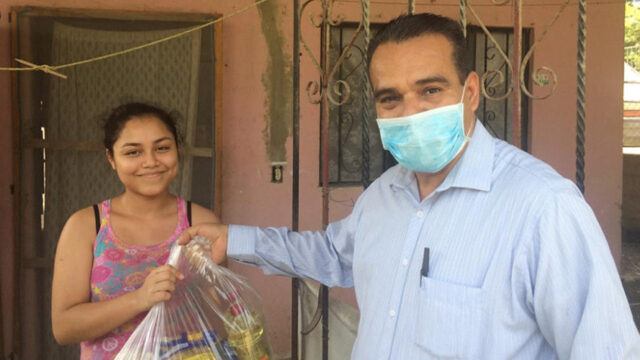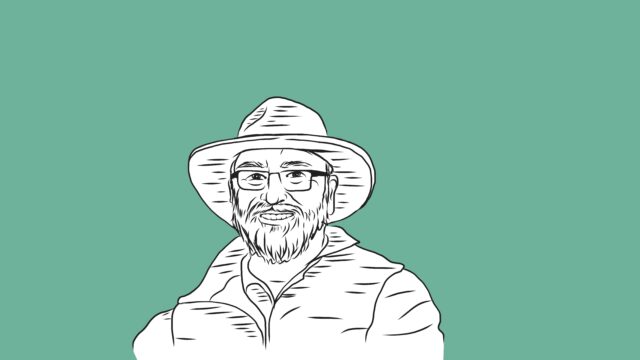How AdventHealth University clinic is giving hope to patients who suffer a stroke.

Gregg Girard spent two years confined to a wheelchair following a stroke in 2014. Then one day, he showed up at Hope Clinic.
“Up until then, all my physical therapy and occupational therapy revolved around teaching me how to get in and out of my wheelchair,” Girard said. “Nobody would teach me how to walk. When I started at Hope Clinic, I was in a wheelchair and they asked me, ‘Why are you in a wheelchair?’ It was the first time in the therapy world that someone gave me that hope, that permission.”
Girard was a successful property manager from Orlando, Florida, living in London, England, 10 years ago. He was 41, physically fit, and living well. Briefly back in the US to obtain a visa, he ended up experiencing a basal ganglia hemorrhage, one of the most severe strokes, caused by uncontrolled hypertension. When he didn’t show up at a party, his friends looked for him and found him on the floor of his home.
He spent the next month in a medically induced coma, following surgery to remove the hematoma, the source of the bleeding in his brain, and to place a shunt to drain fluid. He woke up in the hospital 40 days later with no recollection, and little understanding of how intense a brain bleed he had. He spent four months recovering in the hospital, was discharged to his home in a wheelchair with orders for physical and occupational therapy, and he had his parents move into his Orlando home.
“I was never told I wouldn’t walk again. They told my parents, but they never told me because they didn’t want to discourage me,” Girard said.
Through his own research at home, Girard came to understand what had happened to him and how he might improve his daily functioning. He spent two years at daily outpatient therapy sessions followed by coming home to lie on the couch until dinner time, slowly teaching himself how to get around with a hemi walker. When insurance coverage of his daily therapy sessions ran out, he sought private options and ended up at Hope Clinic, a free clinic operated by AdventHealth University (AHU).
Nine years later, Girard is walking, working, driving, living on his own, and traveling. He continues to visit Hope Clinic for bimonthly maintenance sessions to strengthen his mobility and function. He became one of 64 Hope Clinic patients who participated in a nationally recognized yearlong study in 2020 by Hope Clinic and AHU faculty.
Prestigious Publication
The study, which showed the positive impact of free, weekly, long-term occupational therapy on low-income patients, was published in the August issue of the American Journal of Occupational Therapy.
“It’s very challenging to get published in the American Journal of Occupational Therapy,” Milly Rodriguez, AHU faculty and clinical director of Hope Clinic, and co-author of the study, said. “This is so prestigious and brings great recognition to the important work we’re doing at Hope Clinic.”
Hope Clinic, opened in 2011, is a faculty-led, freestanding clinic providing free occupational therapy (OT) and physical therapy (PT) to children and adults, like Girard, who need treatment but cannot afford it or cannot get it approved by insurance. OT and PT students help patients under the supervision of faculty.
“There’s nothing like our clinic across the United States,” Chia-Wei Fan, associate professor of occupational therapy at AHU and lead author of the study, said.
The significance of the study is the finding that long-term therapy at pro bono clinics can improve the occupational performance of clients.
“This study addressed health disparities in unique and effective ways,” the journal article states. “By using objective measures of functional mobility and self-care, the study provides robust evidence of the faculty-led clinic’s impact in providing underserved and uninsured communities with effective client-centered occupational therapy services.”
The study was funded through the AHU Faculty Research Seed Grant in 2018 that provided US$6,000 — funds used to purchase research software and pay a research assistant. That research assistant was Kathryn Drumheller, second author of the study, who is now a staff therapist in Orange City, Florida.
Key Study Provides Data
While the idea that any patient would improve after a year’s worth of occupational therapy seems entirely plausible, no study had officially shown that yet.
“We needed to be able to show that the impact is real,” Rodriguez said. “Working with an occupational therapist has a good impact on patients’ quality of life. We theorized this was true, but now we have the data to back us up.”
Often, health insurance companies will approve a maximum of six weeks of therapy following surgery, hospitalization, accident, or illness such as a stroke or cardiac event. When the approved number of visits ends, patients are often provided with instructions for activities and movements to do at home.
“With chronic conditions, this study demonstrates a benefit to providing longer periods of therapy for longer periods of time,” Christine Moghimi, chair of AHU’s Occupational Therapy Department and dean of academic leadership, said. “Patients don’t necessarily plateau at six weeks. This study shows that patients can continue to show improvement. Even three or four years post-stroke, therapy can still make a significant impact.”
“This could even open the door to the idea of returning to therapy later on in life,” Moghimi said.
Not all patients will benefit from long-term occupational therapy, but goal setting and assessments can help determine which patients have yet to reach their maximum potential, Rodriguez said.
The study, presented at this year’s American Occupational Therapy Association’s Annual Conference, was featured in the journal’s Authors & Issues YouTube series and granted open access, meaning its content is free and available for download to other health-care professionals and researchers.
For at-risk patients, this study is more than just numbers. It is further proof that if a way exists for them to heal, patients often will thrive, the authors said.
“Being able to access this type of care gives them hope,” Moghimi said. “This underserved population is very motivated to do well and so grateful that something like this exists.”
For Girard, Hope Clinic is exactly as its name implies. “I wish there were more places like Hope Clinic. Having a place like Hope Clinic is just amazing.”
The original version of this story was posted on Southern Tidings.








